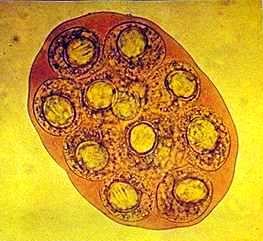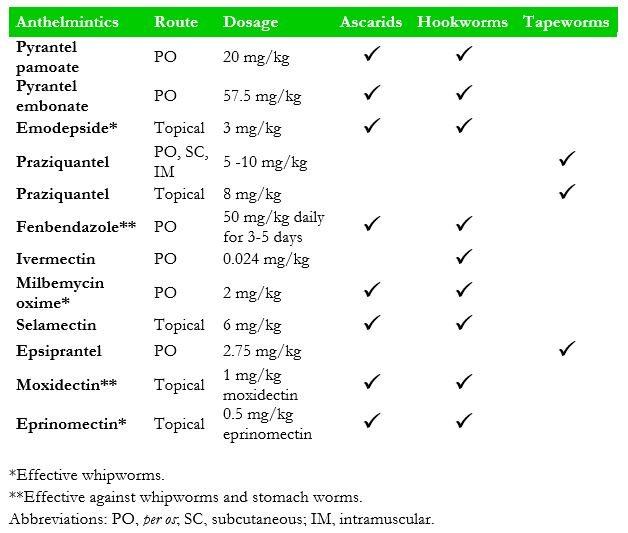Flea Tapeworm
(Dipylidium caninum)
Dipylidium caninum is a common tapeworm of dogs, which can also frequently infect cats. It is zoonotic.
Distribution
Worldwide.
Clinical signs
Dipylidium caninum infections are well tolerated by cats. When present in large numbers, D. caninum can cause constipation or diarrhoea, and cats may present an unthrifty, pot-bellied appearance.

Figure 1. Adult Dipylidium tapeworms with typical ‘barrel’- or ‘cucumber seed’- like proglottids in the small intestines of a cat (Image credit: Dr. A. D. Mihalca)

Figure 2. Dipylidium eggs within a capsule on faecal floatation (Image credit: The University of Melbourne parasite image library)
Diagnosis
Dipylidium caninum infection in cats can be confirmed by detecting characteristic, double pored segments or proglottids (creamy white, cucumber seed shape, approximately 10-12 mm in length) in the faeces or in the perianal area (Fig. 1). Large egg packets (containing eggs approximately 25-40 μm x 30-45 μm) (Fig. 2) may also be detected by standard faecal flotation (SOP 1), but this method presents very low sensitivity and it is therefore not recommended [2].
Treatment
For anthelmintic treatment options refer to Table 1.
Table 1 Routes of administration, dosage and efficacies of commonly utilised anthelmintics against the primary gastrointestinal parasites of cats [1,2].
Prevention and Control
The control of D. caninum can be achieved by treating infected cats at 2 to 4-week intervals and using registered insecticides to keep them free of fleas and lice.
Public health considerations
Dipylidium caninum may infect humans, especially children. Most infected patients are asymptomatic, but nocturnal irritability, anorexia and weight loss may occur in infected people.
References
[1] Low VL, Prakash BK, Tan TK, Sofian-Azirun M, Anwar FHK, Vinnie-Siow WY, AbuBakar S. Pathogens in ectoparasites from free-ranging animals: Infection with Rickettsia asembonensis in ticks, and a potentially new species of Dipylidium in fleas and lice. Vet Parasitol. 2017;245:102-105.
[2] Bowman DD, Hendrix CM, Lindsay DS, Barr SC. Feline Clinical Parasitology. Iowa State University Press, Ames, USA. 2002.
[3] Taton-Allen G, Cheney J. Gastrointestinal parasites. In: Lappin M (ed) Feline internal medicine secrets. Philadelphia, Hanley & Belfus, 2001; p. 85-95.

